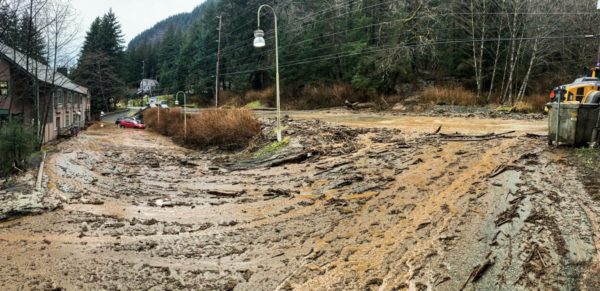
High winds, flooding and landslides caused moderate to severe damage in communities across Southeast Alaska Wednesday, as an atmospheric river stalled over the region and brought record-breaking rain.
“We’re seeing real heavy rainfall amounts all across the panhandle,” said Jonathan Suk with the National Weather Service in Juneau. “I know that some locations have set all-time records for the days, for 24 hours. We’re still sorting through that trying to come up with all those numbers but we are in the process of doing that and it’s looking like a very wet and unfortunately eventful storm system coming through as we also are seeing a lot of landslides, mudslides and flooding across the area.”
RELATED: As record rains drown Southeast, destruction appears worst in Haines
Flooding in Haines was significant on Wednesday. Water and debris washed out and blocked many roadways. School was canceled for the day and city officials urged residents to stay indoors and not travel. A flood watch remains in effect through Thursday morning for Haines and Skagway.
The Juneau airport saw nearly five inches of rain in a 24-hour period — a new record for daily rainfall. City and state crews were busy clearing roadways of mud and debris on Wednesday morning. Many creeks and lakes were at risk of flooding on Wednesday with one to two inches of rain in the forecast through the end of the day.
Juneau resident Rhett Morgan said about 2-3 inches of water flowed into his garage.
“This is like the first flood that I’ve been a part of,” Morgan said. “I didn’t really know what to do at first so I went to Home Depot, and they were closed last night, and banged on the door until they let me get some sandbags.”
He said his neighbors have been placing the sandbags and diverting water since Tuesday night. Juneau’s mayor Beth Weldon showed up to help, too.
Nearly a foot of rain fell in Pelican over the last 48 hours. And heavy rainfall brought Falls Creek near Petersburg to flood stage on Tuesday — the highest level ever recorded on a stream gauge there. Petersburg saw over eight and half inches of rain from the storm as of Wednesday.
In Gustavus, Fire Chief Travis Miller says the Salmon River hit its highest level on Wednesday since monitoring began in 2014.
“No houses floating away, nothing like that,” said Miller. “No major hills — landslides or slides of anything. … No life threatening damage of any sorts.”
As of about noon Wednesday, he says water levels are coming up to some homes’ baseboards and door seals, and the river carved away a small embankment near city hall, but he hasn’t had to close roads.
Across Icy Strait in Hoonah, police Sgt. Joshua Huskey said there hasn’t been any catastrophic damage.
“Yeah, we’ve had quite a few landslides here in town, lot of debris in the roads. The drainage water systems have been flooding over the roads. It’s under control now, though. … It’s just wet and crazy,” he said with a laugh.
The National Weather Service models show the storm front finally starting to move out of the region Wednesday evening, but heavy rain will continue throughout the day until then. There are a number of flood watches and warnings active across the region and even a winter storm warning still in effect for White Pass, which is the only part of the panhandle receiving its precipitation in the form of snow.
The respite for the region will not come as clear skies, but precipitation for Thursday is expected to be “light” and the winds will die down “considerably.”
With reporting from Erin McKinstry, Jeremy Hsieh, Rashah McChesney, Henry Leasia and Joe Viechnicki.




